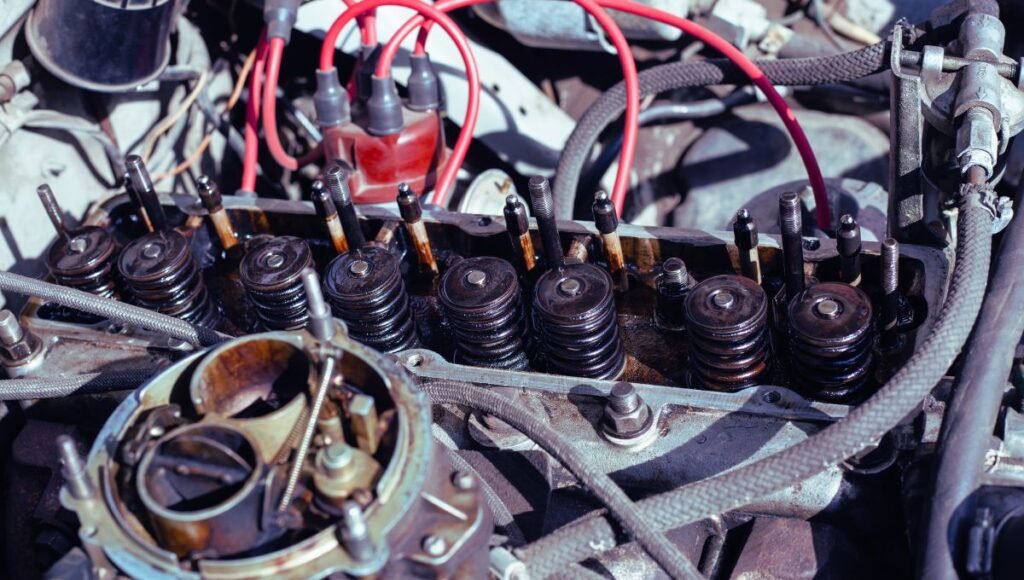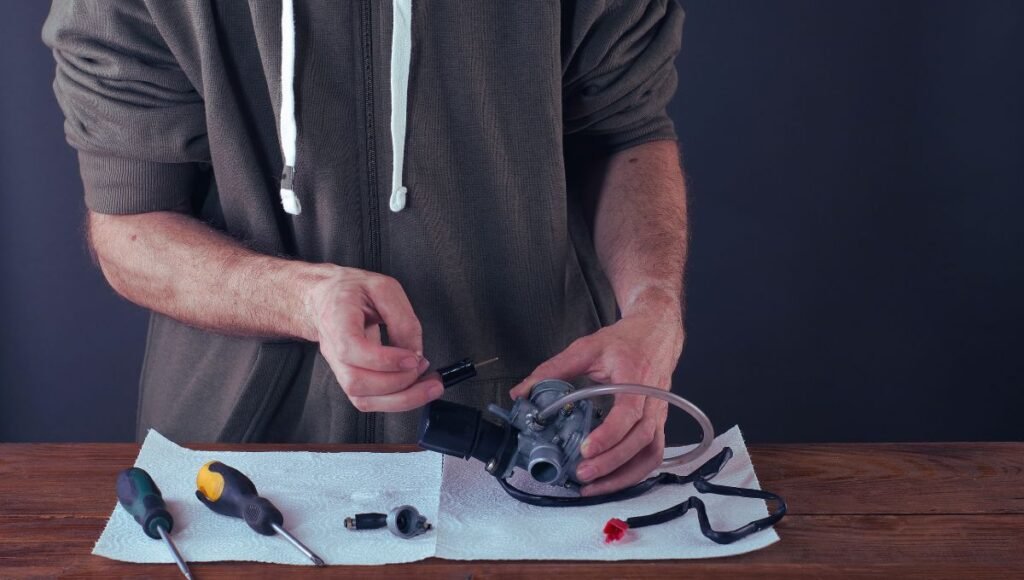Can You Clean a Carburetor Without Removing It? Quick Tips
Yes, you can clean a carburetor without removing it. Use a carburetor cleaner spray for best results.
A carburetor plays a crucial role in mixing air and fuel for internal combustion engines. Over time, dirt and debris can clog the carburetor, affecting engine performance. Cleaning it without removal saves time and effort. Start by accessing the air intake and removing the air filter.
Spray a carburetor cleaner directly into the intake while the engine runs. This method helps dissolve and remove grime from internal components. Regular maintenance ensures better engine efficiency and longevity. Always use high-quality carburetor cleaners and follow safety guidelines. Regular cleaning can prevent costly repairs and keep your engine running smoothly.

Introduction To Carburetor Maintenance
A carburetor mixes fuel and air for an engine. It keeps the engine running smoothly. Carburetor maintenance is important for good performance. Dirty carburetors can cause many problems. Regular cleaning helps maintain your engine.
Importance Of A Clean Carburetor
A clean carburetor improves fuel efficiency. It also provides better power. Engines with clean carburetors start easier. They also run more smoothly. Dirty carburetors can clog and cause engine stalling. This can be dangerous.
Challenges Of Traditional Cleaning Methods
Cleaning a carburetor often means removing it. This can be time-consuming. It can also be difficult. Removing the carburetor requires tools and skills. It may also require new gaskets and seals.
| Challenges | Description |
|---|---|
| Time-consuming | Removing and cleaning takes a lot of time. |
| Skill Level | Requires mechanical skills and knowledge. |
| Extra Parts Needed | May need new gaskets and seals. |
Traditional methods can be frustrating. They can also be expensive. New ways allow cleaning without removing the carburetor. This saves time and effort.
Is It Possible To Clean Without Dismantling?
Cleaning a carburetor without removing it is a common question among enthusiasts. The process might save time and effort. But, does it actually work? Let’s explore this topic in detail.
Pros And Cons Of Non-removal Cleaning
| Pros | Cons |
|---|---|
| Saves time | May not clean thoroughly |
| Reduces risk of damage | Can’t inspect all parts |
| Less technical skill needed | May miss hidden debris |
Common Misconceptions
- It’s as effective as full dismantling: Non-removal cleaning doesn’t reach all areas.
- All carburetor problems can be fixed: Some issues need complete disassembly.
- Any cleaner will work: Specific cleaners are needed for optimal results.
Tools And Materials Needed
Cleaning a carburetor without removing it from the engine requires the right tools and materials. These items ensure the process is efficient and effective. Below, we’ll outline the essential tools and materials needed for this task.
Choosing The Right Cleaning Agents
Using the correct cleaning agents is crucial. Here are some options:
- Carburetor Cleaner Spray: This is a specialized cleaner for carburetors.
- Compressed Air: Helps to blow out debris and buildup.
- Cleaning Brush: A small brush to scrub away stubborn grime.
Ensure the cleaner is designed for carburetors. Other cleaners may damage the carburetor.
Essential Equipment For The Job
Having the right equipment makes the job easier. Here’s what you’ll need:
| Tool/Material | Purpose |
|---|---|
| Screwdriver Set | To access and remove parts if needed. |
| Safety Gloves | Protects your hands from chemicals and grime. |
| Safety Glasses | Prevents cleaner from getting in your eyes. |
| Rags | For wiping off excess cleaner and dirt. |
| Small Container | To catch drips and avoid mess. |
Each tool and material has a specific role. Make sure to gather them all before starting.
Preparation Steps
Before you start cleaning a carburetor, make sure you are ready. Proper preparation ensures a smooth and safe process. Follow these steps to get started.
Safety Precautions
Safety is crucial when working with engines and chemicals. Always follow these safety tips:
- Wear protective gloves to keep your hands safe.
- Use safety goggles to protect your eyes from debris.
- Work in a well-ventilated area to avoid inhaling fumes.
- Keep a fire extinguisher nearby in case of emergencies.
Initial Inspection And Setup
Inspect your carburetor before cleaning. This helps identify any obvious issues. Follow these steps:
- Turn off the engine and let it cool down.
- Locate the carburetor. It is usually near the engine’s intake manifold.
- Check for visible debris or leaks around the carburetor.
- Gather your cleaning tools and supplies. These may include a carburetor cleaner spray, a small brush, and a cloth.
With these preparation steps, you are now ready to start cleaning your carburetor without removing it. Always follow safety precautions and inspect thoroughly.

The Cleaning Process
Cleaning a carburetor without removing it can save time and effort. This section covers various methods to achieve a thorough clean.
Spray Cleaners And Their Application
Using a carburetor cleaner spray is a quick solution. Follow these steps:
- Turn off the engine and let it cool.
- Remove the air filter to access the carburetor.
- Spray the cleaner on the carburetor’s exterior and interior parts.
- Allow the cleaner to sit for a few minutes.
- Wipe off any residue with a clean cloth.
Always wear gloves and safety goggles for protection.
Using Ultrasonic Cleaners
An ultrasonic cleaner can clean intricate carburetor parts. Follow these steps:
- Mix a cleaning solution in the ultrasonic cleaner.
- Place the carburetor parts in the cleaner.
- Set the cleaner to the recommended time and temperature.
- Start the ultrasonic cleaner and let it run.
- After cleaning, rinse the parts with water and dry them.
This method is effective for removing stubborn deposits.
Manual Cleaning Techniques
Manual cleaning techniques involve using brushes and tools. Follow these steps:
- Use a small brush to scrub the carburetor parts.
- Apply a carburetor cleaner to dissolve debris.
- Use a wire brush for hard-to-reach areas.
- Wipe the parts with a clean cloth to remove residue.
- Reassemble the carburetor after thorough cleaning.
This method requires more effort but can be very effective.
| Cleaning Method | Tools Needed | Time Required |
|---|---|---|
| Spray Cleaners | Carburetor cleaner spray, cloth | 15-20 minutes |
| Ultrasonic Cleaners | Ultrasonic cleaner, cleaning solution | 30-60 minutes |
| Manual Techniques | Brushes, carburetor cleaner, cloth | 45-90 minutes |
Aftercare And Maintenance
Cleaning a carburetor without removing it can save time and effort. But ensuring proper aftercare and maintenance is crucial for optimal performance. This section covers the necessary steps to keep your carburetor in top shape after cleaning.
Post-cleaning Checks
After cleaning the carburetor, perform some essential checks:
- Inspect for leaks: Ensure no fuel or air leaks.
- Check the idle: Verify the engine idles smoothly.
- Throttle response: Ensure the throttle responds quickly.
Regular Maintenance Tips
Regular maintenance helps keep the carburetor functioning well. Here are some tips:
- Use clean fuel: Always use clean, high-quality fuel.
- Check air filters: Regularly inspect and clean air filters.
- Inspect fuel lines: Ensure fuel lines are not cracked or leaking.
- Monitor engine performance: Watch for any signs of poor performance.
By following these tips, you can prolong the life of your carburetor and ensure your engine runs smoothly.
Troubleshooting Common Issues
Troubleshooting common issues in a carburetor can be challenging. Sometimes, cleaning it without removing can fix the problem. This section will help you address these common issues effectively.
Dealing With Stubborn Grime
Stubborn grime in the carburetor can cause engine problems. To clean it, use a carburetor cleaner spray. Make sure to spray into all visible openings. Repeat the process if necessary. Use a brush to scrub off any remaining dirt. Pay attention to the jets and air passages.
Sometimes, grime can be very tough. Use a thin wire to clear blockages. Be gentle to avoid damage. After cleaning, spray again to ensure all debris is removed. Let it dry completely before starting the engine.
When To Seek Professional Help
Sometimes, cleaning the carburetor might not solve the issue. If the engine still runs poorly, seek professional help. Professionals have the tools to diagnose deeper problems. They can also remove and clean the carburetor properly.
If you notice any broken parts, don’t try to fix them yourself. A professional should handle such repairs. It ensures safety and proper functioning of your engine.
Regular maintenance can prevent major issues. Keep your carburetor clean and your engine running smoothly.
Advantages Of Cleaning Without Removal
Cleaning a carburetor without removing it offers several benefits. It saves time, reduces costs, and extends the life of your carburetor. This method keeps your engine running smoothly without the hassle of disassembly.
Time And Cost Efficiency
Cleaning a carburetor without removing it is time-efficient. You can complete the task quickly, often in under an hour. This means less downtime for your vehicle or equipment.
Cost efficiency is another key advantage. You avoid the need for specialized tools or professional services. This method reduces expenses, making it a budget-friendly option for maintenance.
Here’s a simple cost comparison:
| Method | Time Required | Cost |
|---|---|---|
| Without Removal | 30-60 mins | $10-$20 |
| With Removal | 2-3 hours | $50-$100 |
Prolonging Carburetor Life
Regular cleaning without removal helps maintain your carburetor. This prevents the build-up of dirt and debris.
Continuous maintenance extends the life of your carburetor. It ensures better engine performance and fuel efficiency.
Here are some tips to prolong carburetor life:
- Use fuel additives to keep the system clean.
- Perform regular inspections for signs of wear.
- Use high-quality fuel to reduce contaminants.
Keeping your carburetor clean without removal is simple and effective. It saves time, reduces costs, and extends the life of your engine.

Frequently Asked Questions
Can You Clean A Carburetor Without Removing It?
Yes, you can clean a carburetor without removing it. Use a carburetor cleaner spray. Spray it directly into the carburetor to remove deposits. Ensure the engine is off during this process.
What Tools Do You Need To Clean A Carburetor?
You need a carburetor cleaner spray, a brush, and safety gloves. Optionally, use a screwdriver to adjust components. These tools help effectively clean without disassembly.
How Often Should You Clean A Carburetor?
Clean your carburetor every six months to a year. Regular cleaning ensures optimal engine performance. Frequency depends on usage and fuel quality.
What Are The Signs Of A Dirty Carburetor?
Signs include rough idling, engine stalling, and poor fuel efficiency. Difficulty starting the engine is also a common indicator. Regular maintenance helps avoid these issues.
Conclusion
Cleaning a carburetor without removing it is possible with the right tools and methods. Regular maintenance can keep your engine running smoothly. Follow the steps carefully to avoid any damage. This approach saves time and effort, making it a practical choice for many.
Keep your carburetor clean for optimal performance.

At AdjustCarburetor, we are passionate about optimizing engine performance and sharing our expertise in carburetors, small engines, fuel injection systems, air-fuel ratios, and ignition timing solutions




